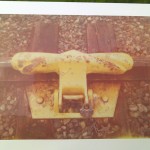Light (Oil sketch)
A fun exercise where I painted from a cell phone picture on a 5″x5″ canvas. I started with a quick charcoal sketch and then painted directly over that. I say “fun” because I can do it rapidly and there is no expectation that it should be good or meaningful a lot like the photo it’s derived from. I may do more of these and it would be nice to even make a commitment to paint one a week. On second thought I’m not even adhering to my Polaroid a week so maybe I will just keep the idea playful.
Fuji Velvia Cross Processed
Or should I say cross possessed? The film base and all the images took on a sickly green cast after being processed in C41 chemicals. That’s somewhat OK as despite it being positive film the processing results in a negative. When the colour is inverted it results in a strong red hue. I found that I got the best results with these “negatives” by scanning them as slides and then batch inverting and processing them in Photoshop. So really what you see is a combination of the cross processing and my choice of how to handle them digitally afterwards.
I should mention that these were all shot with my Yashica Electro GX a fine camera I must say.
Camera Design
With the reaction to the Marc Newson designed Pentax K-01 being in some cases so vehemently negative, you would think that he had created something so anti photography that it marked the end of cameras. It isn’t its just a camera. There have been other instances where camera and design have come together and here is one of them, the Minolta Courreges AC301 (A Minolta Disk 7 in disguise). And in a move that presaged cell phone photography Minolta placed a mirror in the middle of the camera to help with the taking of self portraits, now that was some forward looking design.
The Disk film negative is minuscule compared to almost anything else at 11mm x 8mm so as you can imaging the image quality is not great. While I do have an unexposed in the package disk I think I will just leave it there.
Back to my original point, there have been a number of branches on the tree of photography that have been pruned or just fell off but if no one ever pushed the boundaries of engineering or design it would be pretty boring. So when the K-01 came out many people re-coled in horror before ever actually seeing or holding one. Having now had the opportunity to briefly try one I think the reaction is unwarranted. It is different than what is currently on the market but well within the form of a camera compared to many others from the past (Late breaking news a friend just gave me a Yashica Samurai now you want to see some non camera camera stay tuned for that)
Cameras are not merely for taking pictures they are also a symbol of the user and how they would like to be perceived. Camera makers know this that’s why something like Leica’s red logo conveys so much or why people group together to share their images taken with plastic cameras or cell phones for that matter.
It was bound to happen.
I received a message from the local camera store Lens and Shutter that there was developed film ready for me to pick up. That’s good because I did have a vague notion that I had film out for developing. The thing was I couldn’t remember where I had taken it and with what camera so I was doubly surprised when I got there and was informed that not only was there one roll of film but two. I’m hoping that when I look at the scanned images it will jog my memory but they did have a good suggestion for me to take a picture of the camera in a mirror next time.
I can tell that one was shot with a fixed focal length lens and the other a zoom. Ahhhhh, the Ricoh FF3, now I just need to figure out the other one.
Meanwhile……..first roll scanned and it wasn’t until I actually laid eyes on the Konica Lexio 70 on my shelf that I remembered it was the second camera and roll. Good I’m glad that’s over, it was like hearing a song that you just couldn’t remember the title to. I will post about these cameras soon because they aren’t as forgettable as it seems.
Logs and more (iPad 3 image editing)
I thought I would post these images from today that I took it with the Pentax K-7 and processed on the iPad with Snapseed. While not an ideal workflow I imported the images into Lightroom as this is still the way that I am able to manage the images best. I then sorted and selected a few for further editing on the iPad. To put them on the iPad I use Lightroom’s publish feature to put them in a specific folder for this purpose. That folder is synced to my iPad by iTunes. Once the images are on the iPad it’s as simple as sitting down on the couch and editing.
Now the only problem this creates is that if I import them back into Lightroom I will have what appear to be RAW files and edited versions of them renamed by the iPad. For now I am goint to tag them on import until I can figure out a better way. For reference the iPad 3 has no problems editing these full resolution DNG files but at this point they are being reduced in resolution from 4672 x 3104 down to 4096 x 2721 which I haven’t figured out as yet. Using the iPad is certainly a fun way to edit files and allows for more comfortable seating, now where is my coffee?
Taking pictures today was entirely for fun with Duncan of DLTphotographic and am looking forward to seeing his images too because despite being in the same locations I think we took images of different things. Of course the exception would be the few times the pursuit to fill our cell phones with pictures caused overlap, and I didn’t even see the pile of rail spikes.
Canon Prima Mini
In my ongoing persuit of small film cameras with wide angle lenses I’ve found another, the Canon Prima Mini. While slightly larger than the Pentax UC-1 it too has a 32mm f3.5 lens, but is it up to the task of replacing the Pentax?
While the various shooting modes of the Pentax UC-1 can be selected prior to taking a picture the limited control of the Canon must be done during the exposure. And that control is limited to overriding the automatic control of the flash either on or off by holding down one of the two flash buttons on the side of the camera. These buttons take a fair amount of sideways pressure which isn’t a great idea for holding things steady, besides the fact that there is no feedback from the camera as to the effect they will have. The flash on button covers both fill, slow speed sync and red eye reduction delay override, depending on the situation but you won’t know that only the camera knows and it’s not telling.
Canon gives a specification for the lens of being 3 elements in 3 groups which to me sounds not so groupish and more 3 elmentish. That’s a pretty simple lens but most distortion can be corrected with those three elements.
So you can probably tell from the tone of my writing that I haven’t declared this camera to be the successor to my Pentax UC-1 and you would be right. It did do a decent job and does have that 32mm focal length lens but it’s lack of control really limit it’s use to snap shottery.
Here are some of the images from this camera, having found out though that this camera also came in white I am sure that would be a better performing and I must seek it out (not really but I’d rather have it in white).
Canon Sure Shot Tele
The Canon Sure Shot Tele of 1986 was an attempt by Canon to make a fun camera. And by fun I mean the ability to do multiple exposures and have a built in soft focus filter, what merriment. OK that is more than just take pictures so they should be retro-plauded (Yes I just made that up, the fun is contagious). When I think of soft focus filters I immediately think of the 1980’s so I suppose Canon was right on the money with this one.
The camera has an interesting lens, primarily a 40mm f2.8 and rather than an actual zoom the tele function is a secondary element group that swings into place internally to provide a 70mm f4.9 arrangement. When this happens the front of the camera extends in a manner more reminiscent of a travel trailer room expansion than a camera lens zooming (It’s also slightly noisier). The multiple exposure is implemented by pressing the ME button beside the lens while half pressing the shutter, now when you take the picture the film will not advance. You can repeat this procedure to get multiple multiple exposures and then when you fire the shutter without pressing the ME button the film will advance after that exposure. Did you get that, fun yes?
Two image multiple exposure
Now for the coup de grâce, the soft focus filter. This requires even more dexterity as you need to fully deploy the filter against the spring who’s sole job is to swing it back on you. Once you have fought the filter into place you are ready to permanently obscure your subject, in that 80’s glow. The camera also has back-light compensation and manual flash override and the images are OK but with quite a bit of vignetting. It’s also very noisy in all aspects, noisy like hey look out your about to be hit by a travel trailer! However if soft focus filters and multiple exposures are your idea of fun then this camera is for you and your big hair.
Soft Focus filter
From the field Pentax-iPad-Android
I’m writing this on an iPad that is using my Android phone for it’s Internet access. The image has been converted in camera from a DNG raw file to a jpeg and then loaded to the iPad using the camera connection kit’s SD card reader. The point of all this is really just to test out the usability of the iPad as a photographers tool. It does allow the importing and viewing of the RAW file but the camera provided the most convenient way to convert and resize the image. The key test for me though will be how easily I can import the files to my computer using iTunes as I use my own file locations and work flow.
UPDATE with windows 7 I am able to download my DNG raw files directly from the iPad through Lightroom and all the exif data remains untouched. This is good news and means that in addition to being a great way to view images it can be used as field back up too.
One thing to note if you are importing to the iPad is that you will be prompted to delete the images from the card, personally I like to have a backup so I decline the delete.
For reference 31 RAW files from my Pentax K-7 took just over 3 minutes to import into the iPad. This is from a 30Mb/sec Extreme III card and the “New” iPad.































































